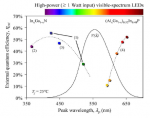Dry.....very dry. :undecided:
Smeee.

Follow along with the video below to see how to install our site as a web app on your home screen.
Note: This feature may not be available in some browsers.

Dry.....very dry. :undecided:


You'd make a fine spindoctor!
Uhm ..... aren't them called acronyms ? ..... (sorry, just kidding)
It's blue in the sense that it's in the blue end of the spectrum. Up until when these diodes were invented in the mid-1990s, the diodes available were all in the red end of the spectrum, ie IR, red, maybe orange-ish. these new diodes came out, and while they were violet, they are in the blue end of the spectrum, away from the red end of the spectrum. Heck, just look at the term "blue-shift": it's often still called a "blue shift", as the counter part to a "red shift", even when you're in the violet or UV wavelengths, even though blue and red are both in the same direction in such cases. So "blue" often is just juxtaposed against red, as in on the blue side of things, towards shorter wavelength.
Then you add in some language barriers since these things were made in Japan, and you end up with the term "blue laser" encompassing blue, indigo, and violet laser diodes.
So it's some combination of marketing, scientific language with the fact that it's the blue-end of the spectrum, and language barriers. Shuji Nakamura's book about the original science on the subject mentions ONLY violet diodes, the highest wavelength in the book is like 415nm, but the book is called "The Blue Laser Diode: The Complete Story". Anyone want to go tell him he's wrong?
When they were working on the diode perhaps it was blue at first but they realized that making it even deeper into the wavelength would allow them to store more space.
Nope, sorry. Blue is harder to make than violet, but quite some margin. The first laser diodes that were actually blue weren't made until years after the first violet ones. And yet they were all called "blue", even when they were only violet.
As I understand it, they used new materials and got blu-ray. They tweaked and experiemented until they could push the wavelength of this new material up a good 40nm. I wonder how they're gonna do green?
Offtopic, but ..... :thinking: i'm just wondering, why they have not started to research also about Gallium 3 Phosphide resonators, too, instead only Gallium Nitride ? ..... after all it already emits in the yellow range (where GaN actually reach 570nm emissions only, as far as i remember, and only for LEDs) ..... or is just that it cannot be built a crystal structure "pure" enough for be used as cavity for the resonator, with GaP ? :thinking:



